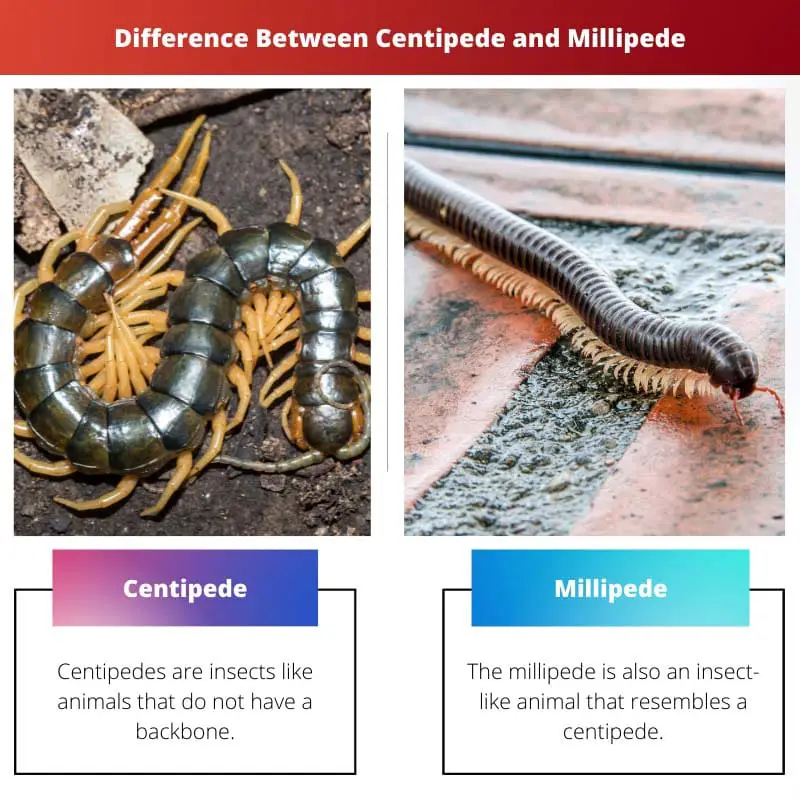Earth is filled with lots of strange animals and insects. The range of these organisms is so large that many look similar. But one can find the difference between them by studying their species.
Centipedes and millipedes are two creatures with quite a similar appearance with many major differences.
Key Takeaways
- Centipedes are carnivorous arthropods with one pair of legs per body segment, while millipedes are herbivorous or detritivorous arthropods with two pairs per body segment.
- Centipedes have flattened, elongated bodies and are faster-moving, while millipedes have cylindrical bodies and move slowly.
- Centipedes possess venomous claws for capturing prey, whereas millipedes do not have venom and instead rely on their hard exoskeleton for protection.
Centipede vs Millipede
The difference between centipedes and millipedes is that the centipedes are flatter in body structure and have visible segments. On the other hand, millipedes are cylindrical, and their segment is so near that to appear to be sunken into each other. Centipedes and millipedes belong to the same family but have multiple differences.

Centipedes are insects like animals that do not have a backbone. They have long bodies, almost like pens, with many legs attached to them.
There are two antennas at the head of the centipedes. They belong to the Animalia kingdom and can be both animals or insects.
The millipede is also an insect-like animal that resembles a centipede. The scientific name used in place of Millipede is Diplopoda.
Millipedes are a member of the phylum known as Arthropoda. The segment of their body are fused, and each segment has two legs. Several features of millipedes distinguish them from a centipede.
Comparison Table
| Parameters Of Comparison | Centipede | Millipede |
|---|---|---|
| Length | The colours in which centipedes are found are greyish-yellow and sometimes brown. They come in different shades. | The colours in which millipedes are found are Black and brownish-red. They also come in different shades. |
| Shape | The centipede is flat in shape and looks terrific and odious. They are divided into multiple segments. | The millipedes are cylindrical and also look terrific and odious. They are segments that are fused. |
| Colour | An average millipede can be 1 to 8 inches long, which makes almost 20.32 centimetres. | There is one pair of legs per segment in a centipede, and they can have 354 legs at maximum. |
| Legs | The average number of eggs that a centipede can lay is 40 to 50 at an extent. | There are two pairs of legs per segment in a millipede and they can have 200 legs at maximum. |
| Eggs | The average number of eggs that a millipede can lay is around 300. | The average number of eggs that can be laid by a millipede is around 300. |
What is Centipede?
Centipedes are disgusting and dangerous critters found everywhere but not in human societies. Their body is divided into segments, each with a pair of legs attached to it.
The scientific name that is given to a centipede is Chilopoda. The name ‘centipede’ is derived from a Latin word where ‘centi’ means hundred and ‘pede’, which is ‘pedis’ means ‘foot’.
Most species of centipedes are very venomous, and their bite feels very painful. They’re known to inflict their legs on the skin of a person.
They use appendages that have a shape similar to pincers to inject their venom into the body of a person. The number of legs owned by a centipede can vary between the range of 30 to 354, depending on the particular species.
They are members of the phylum known as Arthropoda. The shape of the head of a centipede is flattish and round. Centipedes tend to live under something like a stone and in dark areas.
Many other small invertebrates are included in the diet of a centipede.
They mostly hunt at night. There are various types of centipedes, including stone centipedes, house centipedes, Scolopendridae, Geophilomorpha, etc. Centipedes move quite rapidly with their many legs.

What is Millipede?
Millipedes are smaller than centipedes. Millipedes are detritus feeders. They survive by eating decomposed plants and leaves. Some species are also eating fungi.
Millipedes move around at a slower speed. Unlike centipedes, millipedes are harmless. But if they become garden pests, millipedes can destroy newborn seedlings. Some chemicals produce from the pores of the millipede’s body.
These chemicals help them to defend themselves from predators. Some species of millipedes are covered with bristles that can be detached. Experts claim that almost 12 thousand species of millipedes exist on Earth.
Millipedes can be seen everywhere with slight changes in their body. An average millipede can be 2 to 280 millimetres long.
Just like the length, segments found in millipedes can also vary. They can be found from 11 to 100. An antenna is attached to the head of a Millipede and they have only one maxilla.
There is 16 order in which Diplopodas are divided. One order of millipede has a calcareous dorsal plate that works as armour.
Millipedes do not bite to defend themselves; instead, they produce toxic liquid from their lateral glands. They are not considered to be harmful, but this liquid can cause infection in some people or animals.

Main Differences Between Centipedes and Millipedes
- The size of legs in a centipede is longer that can be extended sideways while millipedes have small legs that do not extend.
- When it comes to moving around, centipedes are fast. On the other hand, millipedes are species that move very slowly.
- Centipedes live on eating small worms and other organisms, while millipedes are the critters that eat decomposed plants and leaves.
- Most species of centipedes have a yellow and brown colour. On the other hand, millipedes have brownish-red and black colours.
- Centipedes are venomous and deliver painful bites to a person, while millipedes aren’t venomous, but they can harm seedlings.





